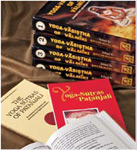
 Are There Other Types of Sacred Texts?
Are There Other Types of Sacred Texts?
India’s lofty philosophical texts expound diverse views in exacting dialectics. Yoga treatises unveil the mysterious path to ultimate samadhis. Intimate devotional hymns disclose the raptures of consummate divine love. Aum.§
A recluse, clearly immersed in his yoga sadhana, sits in meditation beneath a gnarled banyan tree. At left are displayed two primary yoga scriptures, Yoga Sutras and Yoga Vashishtha. In the background, a young lady lights a ghee lamp to offer in personal worship, as her ancestors have done for centuries.§
 N ADDITION TO THE EPICS, LEGENDS AND SUPPLEMENTS to the Vedas and Agamas, there is a wealth of Hindu metaphysical, yogic and devotional writings. Considered foundational are the early texts defining the six philosophical darshanas: the sutras by Kapila, Patanjali, Jaimini, Badarayana, Kanada and Gautama. Hailed as leading occult works on yoga, asanas, nadis, chakras, kundalini and samadhi are the Yoga Sutras, Tirumantiram, Yoga Vasishtha, Siva Sutras, Siddha Siddhanta Paddhati, Jnaneshvari, Hatha Yoga Pradipika and Gheranda Samhita. Widely extolled among the bhakti literature are the Bhagavad Gita, Narada Sutras, Tiruvasagam, the Vachanas of the Sivasharanas and the hymns of mystic poets like Surdas, Tukaram, Ramprasad, Mirabai, Andal, Vallabha, Tulasidasa, Tayumanavar, Lalla, Tagore, Auvaiyar and the saintly Nayanars and Alvars. The Bhagavad Gita explains, “As a blazing fire reduces the wood to ashes, O Arjuna, so does the fire of knowledge reduce all activity to ashes. There is nothing on Earth which possesses such power to cleanse as wisdom. The perfect yogin finds this knowledge in himself by himself in due time.” Aum Namah Sivaya.§
N ADDITION TO THE EPICS, LEGENDS AND SUPPLEMENTS to the Vedas and Agamas, there is a wealth of Hindu metaphysical, yogic and devotional writings. Considered foundational are the early texts defining the six philosophical darshanas: the sutras by Kapila, Patanjali, Jaimini, Badarayana, Kanada and Gautama. Hailed as leading occult works on yoga, asanas, nadis, chakras, kundalini and samadhi are the Yoga Sutras, Tirumantiram, Yoga Vasishtha, Siva Sutras, Siddha Siddhanta Paddhati, Jnaneshvari, Hatha Yoga Pradipika and Gheranda Samhita. Widely extolled among the bhakti literature are the Bhagavad Gita, Narada Sutras, Tiruvasagam, the Vachanas of the Sivasharanas and the hymns of mystic poets like Surdas, Tukaram, Ramprasad, Mirabai, Andal, Vallabha, Tulasidasa, Tayumanavar, Lalla, Tagore, Auvaiyar and the saintly Nayanars and Alvars. The Bhagavad Gita explains, “As a blazing fire reduces the wood to ashes, O Arjuna, so does the fire of knowledge reduce all activity to ashes. There is nothing on Earth which possesses such power to cleanse as wisdom. The perfect yogin finds this knowledge in himself by himself in due time.” Aum Namah Sivaya.§
